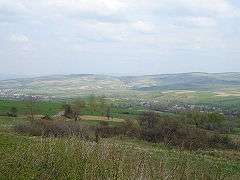Karlików
| Karlików Карликів | |
|---|---|
| village | |
 | |
| Coordinates: PL 49°26′04″N 22°04′01″E / 49.4344779°N 22.0668983°ECoordinates: PL 49°26′04″N 22°04′01″E / 49.4344779°N 22.0668983°E | |
| Country | Poland |
| Beskids | Subcarpathian Voivodship |
| Founded | 1483 |
| Area | |
| • Total | 8.8 km2 (3.4 sq mi) |
| Elevation | 290 m (950 ft) |
| Population | |
| • Total | 120 |
| Time zone | CET (UTC+1) |
| • Summer (DST) | CEST (UTC+2) |
| Postal code | 38507 |
Karlików (Ukrainian: Карликів, Karlykiv; Rusyn: Карликів, Karlykiv) is a village situated in the Subcarpathian Voivodship (province) of south-eastern Poland; previously in Krosno Voivodship (1975-1998) and Sanok district, (10 mi or 16 km east of Sanok). Karlików is about 10 mi (16 km) from Sanok. It is situated below the main watershed at the foot of the Słonne Mountain, and has an elevation of 340 m (1,115 ft).
Karlików– Karlykow 1483, Karlowa 1488, Karlikow 1557, Karlikow 1589, Karłykiw 1867, village in eastern Lesser Poland, in the Lesser Beskid mountains, Bukowsko rural commune.
History


Karlików was founded in 1483 by the Bals de Lobetanz family. From 966-1018, 1340-1772 (Ruthenian Voivodeship, Sanoker County) and from 1918-1939 Zboiska was part of Poland. From 1772 to 1918 it belonged to the Austrian empire. This part of Poland was controlled by Austria for almost 120 years. At that time the area (including west and east of Subcarpathian Voivodship) was known as Galicia. In 1785 the village lands comprised 61 łan.
The village was part of the Ukrainian Catholic Apostolate in 1936, and the parish priest at the time was Oleksiy Malarchyk. Filial churches to Karlykiv were located in neighboring Prybyshiv (Przybyszow) and Volia Petrova (Wola Piotrowa.) The majority of the village's residents were Lemko in ethnicity (Lemkos are an eastern Slavic regional ethnic group/Carpathian "highlanders." In this village, most Lemkos considered themselves to be Ukrainian.) Following World War II, the village was burned down in the spring 1946 by the Polish Communist Army, which deported many of the Lemkos they could locate to Soviet Ukraine per an agreement with the Soviet Union. In 1947, Father Malarchyk and his family (including his four-year-old granddaughter) were murdered by Polish agents in the midst of ethnic warfare and instability that had spread throughout Southeast Poland, as the Ukrainian Insurgent Army clashed with Polish forces. During the final ethnic cleansing campaign, known as "Akcja Wisla" (or Operation Vistula) on 29 April 1947, most or all of the remaining Lemkos were forcibly deported to the Silesia area of Western Poland.
Karlikow Today: Today, Karlikow is still a rural village inhabited mostly by ethnic Poles. It contains a ski slope which attracts seasonal tourism. The cemetery in Karlikow still contains headstones of the Lemko families who once lived there.
Twin cities
See also
- Komancza Republic (November 1918 – January 1919)
References and literature
- Prof. Adam Fastnacht. Slownik Historyczno-Geograficzny Ziemi Sanockiej w Średniowieczu (Historic-Geographic Dictionary of the Sanok District in the Middle Ages), Kraków, 2002, ISBN 83-88385-14-3.
